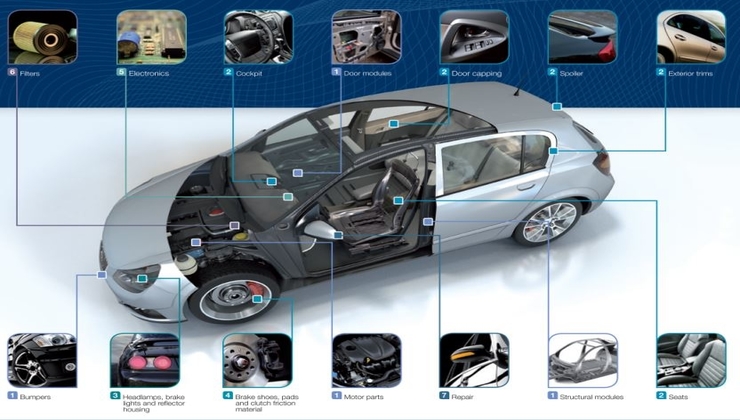
On the back of flourishing construction industry and emphasis on lightweight robust materials across other industries including automotive and aerospace, the global composites market will continue returning healthy profits, as per the findings of a new business publication from IndustryARC. According to the report, the global composite materials market demand will grow at a notable CAGR of around 6% over the forecast period of 2019 to 2025, incrementing perpetually from an estimated valuation of around $26 billion as of 2018. The report is titled “Composite Materials Market: by material (fibre reinforced polymers, resins, matrices, others) by application (aerospace, construction, wind energy, automotive, others) by method (open moulding & closed moulding); by geography - forecast (2019 - 2025).”
Browse 77 Market Tables, 178 Figures spread through 180 slides and an in-depth TOC “Composite Materials Market (2019 - 2025)”
Global Composite Materials Market: Leading Segments
APAC holds the maximum share of 45%, and is estimated as the key region for the growth of composite materials market during the forecast period. The surge in this region is expected due to the increasing usage of composite materials in transportation, aerospace, and construction applications. Additionally, fiberglass composites used for designing the printed circuited boards is driving the market growth in this region.
According to the report analyst, construction industry is the largest end user of the composite materials; it is estimated to grow with a good CAGR around 7% during the forecast period 2019-2025. The most common available material of composite is concrete. As composites are extremely durable, low weight, design flexibility, corrosion resistance, and impact resistance materials, they are widely used in the construction industry. Due to their design flexibility property, historical replications, and complex designs of buildings can be easily constructed.
Global Composite Materials Market Analysis
Archaeologists say that humans have been using composites for at least 5,000 to 6,000 years. In ancient Egypt, composites made from mud and straw were used as bricks to cover and strengthen wooden structures such as forts and monuments. In the modern era, composites are now reused with the invention of early plastics such as bakelite and vinyl along with engineered wood products like plywood. Composites are lightweight materials that are much stronger and stiffer than pure polymers.
In 2018, there were 26,307 aircraft fleets; in the next 10 years there will be 3.7 % net annual growth, increasing the fleet to 37,978. Some composite solutions are autonomously planned, and advanced for the aircraft seats in planes such as P750Xstol and Cessna 208 Caravan in South Africa. The increasing usage of composite materials in aircrafts, military, and automotive applications are the factors driving the growth of the composite materials market during the forecast period of 2019 to 2015.
Global Composite Materials Market: Trends
Introduction of new hybrid glass and carbon fiber for composite applications in the automotive, marine, and sporting goods industries by Owens Corning. This latest innovation of the company combines the best of glass and carbon fibers into a unique material which increases dissemination of composites against metals.
The high-strength composite materials used in advanced applications which includes elevated temperature conditions, are typically, continuous fibrous material embedded in a metal matrix composites material that acts to hold the fibers together.
The turbo machinery industry is increasingly showing interest in the use of ceramic-matrix composites (CMCs). This class of composite materials is primarily apt for extremely high temperature applications such as the hot section components of aircraft engines and land-based gas turbines.
Global Composite Materials Market: Competitive Landscape
Some of the other players operating in the global composite materials market are Owen Corning, Solvay, SGL Group, and Toray Industries. Solvay the global provider of technologically advanced light-weighting material solutions has appointed, Composites One, the national leading supplier of composite materials as a new North America distributor for its process materials and tooling product lines. Both companies offer a large range of consumables, including release films, vacuum bagging films, peel plies, release fabrics, breather fabrics, sealant tapes and adhesive tapes in the North America region.
Talk to one of our sales representative about the full report by providing your details in the link below:
https://www.industryarc.com/support.php?id=246
Related Reports:
Advanced Materials Market: By Product Type (Light Weight Materials, Bio-Based Materials, Ceramics, Colloids, Nanomaterials, Smart Materials, Catalysts, Fibers, Plastics, Resins, Composites, Polymers, Woven & Non-Woven Materials, Conductive Materials, Organic Materials, Insulation Materials, Packaging Materials, Biomedical Materials, Graphene, Others), By End-User Industry (Building & Construction Industry, Aerospace Industry, Marine Industry, Defense, Automotive Industry, Electrical & Electronics Industry, Oil & Gas Industry, Health Care Industry, Paints & Coatings Industry, Others), By Geography (North America, Europe, Asia Pacific, South America, Middle East & Africa) - Forecast(2018-2023)
https://www.industryarc.com/Report/15380/advanced-materials-market.html
Aerospace Composites Market: By Components (Fiber, Resin); By Aircraft (Business, Commercial, Civil, Military, ); By end-user Industry (Aerospace); By Geography - Forecast(2018-2023)
https://www.industryarc.com/Report/16454/aerospace-composites-market.html
About IndustryARC:
IndustryARC is a research and consulting firm that publishes more than 500 reports annually in various industries, such as Agriculture, Automotive, Automation & Instrumentation, Chemicals and Materials, Energy and Power, Electronics, Food & Beverages, Information Technology, Life sciences & Healthcare.
IndustryARC primarily focuses on Cutting Edge Technologies and Newer Applications of the Market. Our Custom Research Services are designed to provide insights into the constant flux in the global demand-supply gap of markets. Our strong analyst team enables us to meet the client research needs at a very quick speed with a variety of options for your business.
We look forward to supporting the client to be able to better address customer needs; stay ahead in the market; become the top competitor and get real-time recommendations on business strategies and deals. Contact us to find out how we can help you today.
Contact Us:
Mr. Venkateshwar Reddy
Business Development Manager
Email: sales@industryarc.com
Contact Sales: 1-614-588-8538 (Ext-101)

 Log in with Facebook
Log in with Facebook 








